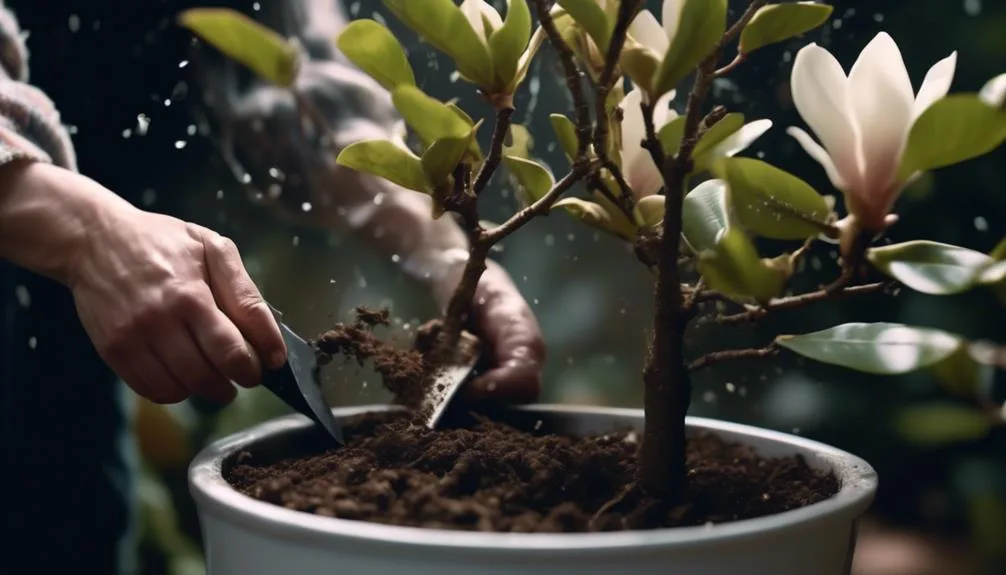Wondering if you can grow your own magnolia trees?
Magnolias are stunning and add beauty to any garden.
This article explores how to successfully propagate magnolia trees, whether you're an experienced gardener or just starting out.
Learn the methods and techniques to expand your garden or share the beauty of magnolias with others.
Propagating these trees can be a fulfilling endeavor, and this article will guide you through the process.
Selecting the Propagation Method
When selecting the propagation method for your magnolia trees, consider the specific characteristics and needs of the tree as well as your own resources and expertise.
Air layering is a technique where you encourage the tree to grow roots on a branch while it's still attached to the parent tree. This method is ideal for magnolias because they often have large branches and it allows you to create a new tree that's genetically identical to the parent.
On the other hand, seed germination involves growing a new tree from a seed. While this method offers genetic diversity and can be an enjoyable process, it takes longer for the tree to mature and start blooming.
Considering the time, effort, and resources you have available will help you choose the best propagation method for your magnolia trees.
Gathering Propagation Materials
To successfully gather propagation materials for your magnolia trees, begin by assessing your needs and ensuring you have the necessary tools and supplies at hand. Here's what you need to consider:
- Soil Moisture: Before gathering materials, check the soil moisture where you plan to propagate your magnolia trees. You may need to adjust the moisture levels to support successful propagation.
- Test the soil moisture using a soil moisture meter.
- Prepare a well-draining propagation medium to control the moisture levels during the propagation process.
- Humidity Levels: Magnolia trees often require specific humidity levels for successful propagation.
- Use a hygrometer to monitor the humidity levels in the propagation environment.
- Consider using a humidity dome or misting system to maintain the required humidity levels.
Preparing the Magnolia Cuttings
Consider assessing the health and vigor of the magnolia tree from which you plan to take cuttings, ensuring they're free from disease and pests.
Once you have identified a healthy branch, it's time to prepare the cuttings. Start by choosing a well-draining potting mix with equal parts peat moss and perlite to promote healthy root growth. This will provide the right balance of moisture and aeration for the cuttings.
Fill a clean container with the potting mix, and moisten it slightly. Then, take 4- to 6-inch cuttings from the healthy branches, making sure to include at least two leaf nodes. Remove the lower leaves to expose the nodes and dip the cut end in a rooting hormone to encourage root development.
Lastly, place the cuttings in the prepared pot and cover them with plastic to control humidity, creating a mini greenhouse environment for successful propagation.
Planting and Caring for Cuttings
Planting and caring for the cuttings requires attention to proper watering, light exposure, and protection from extreme temperatures to foster their healthy growth. When planting and caring for your magnolia cuttings, consider the following:
- Rooting hormone: Before planting the cuttings, dip the ends in rooting hormone to promote healthy root development.
- Watering schedule: Establish a consistent watering schedule to keep the soil consistently moist but not waterlogged, ensuring the cuttings have the necessary hydration for growth.
- Light exposure: Place the cuttings in a location with indirect sunlight to encourage healthy growth while protecting them from harsh, direct sunlight.
Monitoring and Troubleshooting
As you monitor the growth of your magnolia cuttings, observe them for any signs of wilting, discoloration, or pest infestation to address any potential issues promptly. This vigilance is crucial for disease prevention and ensuring the healthy development of your new plants.
If you notice any concerning symptoms, such as yellowing leaves or unusual spots, take action immediately. Consider adjusting the watering schedule or inspect the cuttings for any signs of root rot.
Additionally, regularly check for any pest activity and apply appropriate measures to mitigate infestations.
Furthermore, ensure that your rooting hormone applications are being absorbed effectively by the cuttings to encourage robust root development.
Conclusion
As you embark on your magnolia tree propagation journey, remember to carefully select the method, gather the materials, and nurture the cuttings with patience.
By closely monitoring and addressing any issues, you can successfully propagate these beautiful trees, creating a lasting natural legacy.

My interest in trees started when I first saw the giant sequoias in Yosemite.
I was a teenager then, and I remember thinking, “I need to learn more about this.”
That moment stuck with me.
A few years later, I went on to study forestry at Michigan Tech.
Since graduating, I’ve worked in a mix of hands-on tree care and community education.
I’ve spent over ten years helping people understand how to plant, maintain, and protect the trees in their neighborhoods.
I don’t see trees as just part of the landscape.
They are living things that make a real difference in our daily lives.
